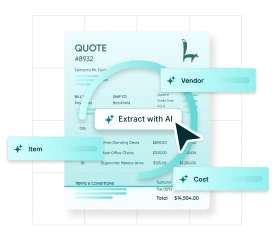The 4 T&E Spend Processing KPIs That You Should Be Measuring Today
You’ve built a solid travel & expense policy — but how do you know it’s actually working?
After rollout, success isn’t about the number of receipts processed. It’s about speed, cost, accuracy, and employee trust.
In this guide, we’ll show you the four T&E KPIs every finance leader should track to measure performance, spot bottlenecks, and uncover automation opportunities.
If your results fall short, it might be time to refresh your policy with our free 2025 T&E Policy Template.
Why tracking T&E KPIs matters
A travel and expense policy provides structure. KPIs prove whether it’s effective.
When organizations monitor the right performance indicators, they gain the visibility to reduce waste, speed up reimbursements, and strengthen compliance.
Here’s what good T&E measurement delivers:
- Operational efficiency: Identify slow purchase approval workflows and redundant handoffs.
- Cost visibility: Understand the true cost of processing reimbursements.
- Employee trust: Fast, predictable repayments reduce friction and frustration.
- Policy alignment: See if employees follow your rules — or if the rules need adjusting.
- Automation ROI: Measure the impact of tools that streamline submissions and approvals.
Without these metrics, business expenses and reimbursements become guesswork — and small inefficiencies quietly erode time, money, and morale.
The four T&E KPIs every company should track
These four metrics give finance leaders a balanced view of T&E performance — covering cost, productivity, efficiency, and cycle time. The benchmarks below are based on APQC research across industries and company sizes.
1. Total Process Cost per $1,000 Revenue (Cost KPI)
This measures the total expense reimbursement cost — labor, systems, outsourcing, and overhead — normalized by revenue.
Why it matters: It reveals how much your organization spends just to process reimbursements, not the reimbursements themselves. Lower costs indicate a more efficient, automated workflow.
Benchmark: Median ≈ $0.17 per $1,000 revenue
That’s ≈ $170,000 annually for a $1 billion company.
2. T&E Disbursements per FTE (Productivity KPI)
How many reimbursements does each full-time equivalent in finance or AP handle per year?
Why it matters: It gauges output per person — and highlights whether AP automation or workload balancing is improving throughput.
Benchmark: ≈ 7,700 disbursements per FTE per year
3. FTEs per $1 Billion Revenue (Efficiency KPI)
The number of employees required to manage reimbursements relative to company revenue.
Why it matters: Fewer FTEs per revenue unit typically means leaner, more efficient processes, and better use of automation.
Benchmark: ≈ 1.7 FTEs per $1 Billion Revenue
4. Reimbursement Cycle Time (Speed KPI)
How long does it take from expense submission to payment?
Why it matters: Shorter cycles improve employee satisfaction and cash-flow predictability. They also signal strong process discipline. See how to improve your purchase order cycle.
Benchmark: ≈ 5 days to approve and schedule reimbursements
Modernizing T&E: The power of expense and card solutions
Tracking KPIs tells you where your T&E process stands. Transforming them means changing how spending happens in the first place.
That’s where modern expense and card solutions make the biggest difference.
Traditional expense management is reactive — employees pay out of pocket, managers approve after the fact, and finance teams spend weeks reconciling transactions that should’ve been visible from day one.
The result? Delays, blind spots, and frustration for everyone involved.
Integrated expense and card systems flip that model on its head. They bring T&E into the flow of work — where control, compliance, and visibility happen before the money moves.
Here’s how:
- Pre-approved control: Employees spend with cards tied to policy limits, cost centers, or budgets — eliminating the guesswork and reimbursement lag.
- Real-time visibility: Every transaction appears instantly, giving finance teams live data to monitor budgets and forecast cash flow.
- Built-in compliance: Category rules, approval workflows, and automatic receipt capture stop errors and policy violations before they happen.
- Mobile freedom: Approvals, submissions, and card management can happen anywhere — critical for remote teams and frequent travelers.
Together, these shifts turn T&E from a reactive reimbursement process into a proactive spend system.
And the impact shows up directly in your KPIs: faster cycle times, lower processing costs, fewer exceptions, and happier employees.
How to improve your T&E KPIs
Once you start tracking these metrics, use them to drive action — not just reporting.
Every improvement to your process — from how approvals happen to how expenses are captured — directly moves the needle on cost, speed, and accuracy.
Automate approvals
Replace manual email chains with structured approval routing. Automation shortens cycle time, reduces human error, and keeps both expense and card transactions within defined limits. Fewer manual touchpoints mean faster reimbursements and cleaner data for KPI tracking.
Centralize receipts and data
Consolidate every transaction — scanned receipts, digital uploads, and card charges — into a single system of record. When finance can see the entire picture in one place, reconciliation accelerates and reporting accuracy improves.
Simplify your policy
Ambiguous policies create friction and non-compliance. Use clear thresholds, consistent rules, and simple examples that employees can easily follow. Make sure your expense and card policy is mobile-accessible so employees can check what’s allowed before they spend — reducing after-the-fact corrections.
Set reporting cadence
Don’t wait for quarter-end reviews. Understand and review procurement KPIs and spend insight monthly to spot slow approvals, off-policy spend, or unusual card activity. Regular reporting turns reactive fixes into proactive improvements.
Benchmark and recalibrate
Compare results across departments, cost centers, and card programs. Use performance trends — like average reimbursement time or cost per transaction — to identify what’s working and where processes need tuning. The goal isn’t perfection, but measurable progress over time.
When KPIs Signal It’s Time to Refresh Your Policy
Your metrics don’t just measure performance — they flag when your policy or systems need an update.
Watch for these signs:
- Reimbursements regularly take longer than 7 days.
- Employees submit out-of-policy expenses.
- Finance staff are overwhelmed by manual reviews.
- Costs to process reimbursements keep rising.
If you’re seeing these patterns, it’s time to revisit your policy design and workflows. Refresh your policy, reinforce accountability, and modernize how your organization manages travel and expense spend.
Download the 2025 Travel & Expense Policy Template
FAQ
Q: How often should T&E KPIs be reviewed?
Monthly review is ideal; quarterly at minimum. Frequent checks catch slowdowns early.
Q: What’s a good target for reimbursement cycle time?
Five days or less. Best-in-class organizations achieve same-week reimbursements.
Q: Which tools help track these KPIs?
Modern AI-powered spend-management platforms that combine expense reporting, approvals, and analytics give real-time KPI visibility.
Q: Do benchmarks vary by industry?
Yes. You can use this data pulled from APQC to get an idea, but to compare with organizations in your industry, check out the Procurement Benchmark Report.
Q: How does AI make the expense approval process better?
AI streamlines the approval process by automatically flagging policy violations, detecting duplicate or suspicious submissions, and categorizing expenses for faster routing.
It reduces manual review time, ensures consistent policy enforcement, and helps finance teams reimburse employees faster — all while capturing cleaner data for KPI tracking.

Preview AI Intake for Orders
Take the product tour to see how the new intake experience works.
